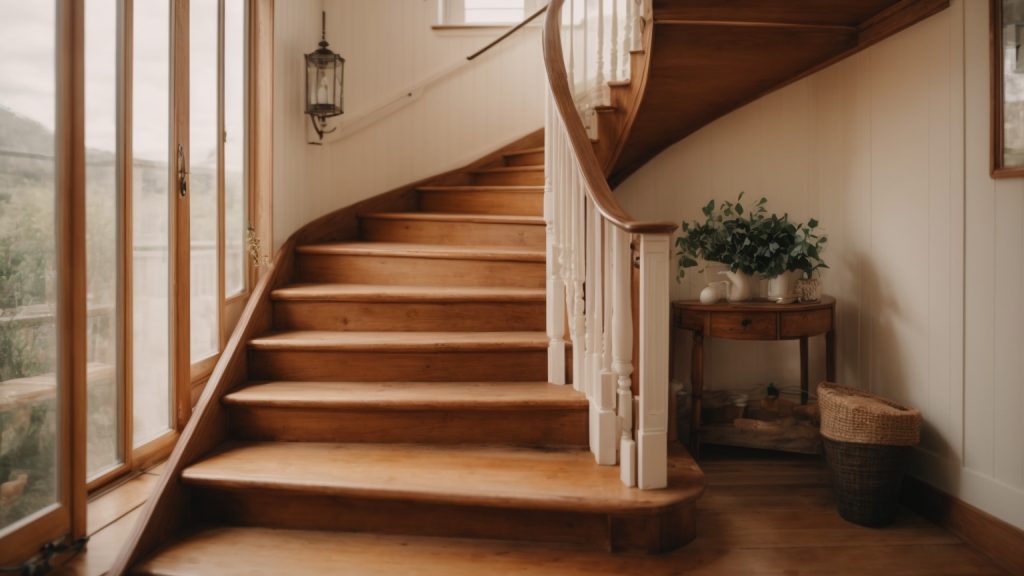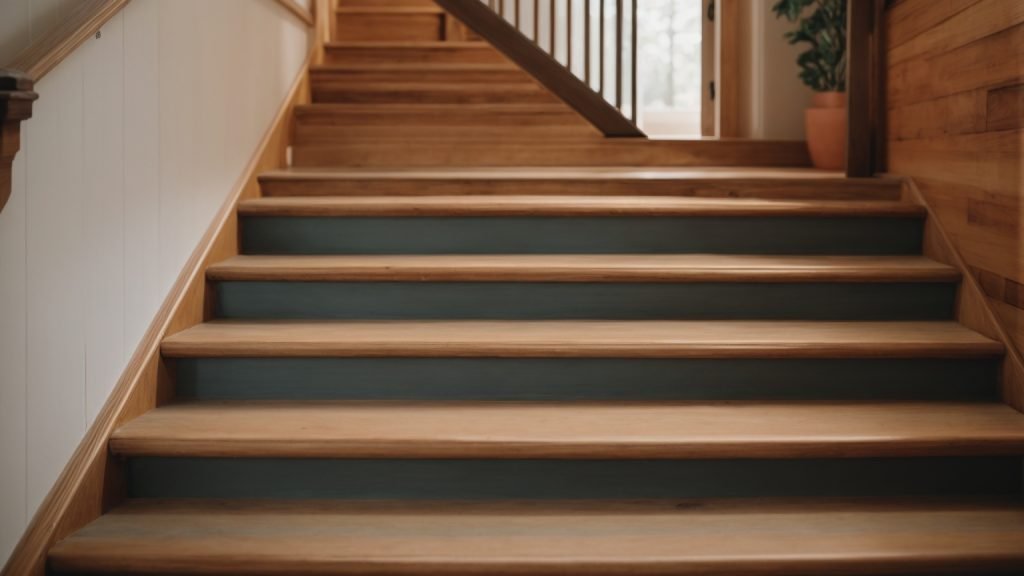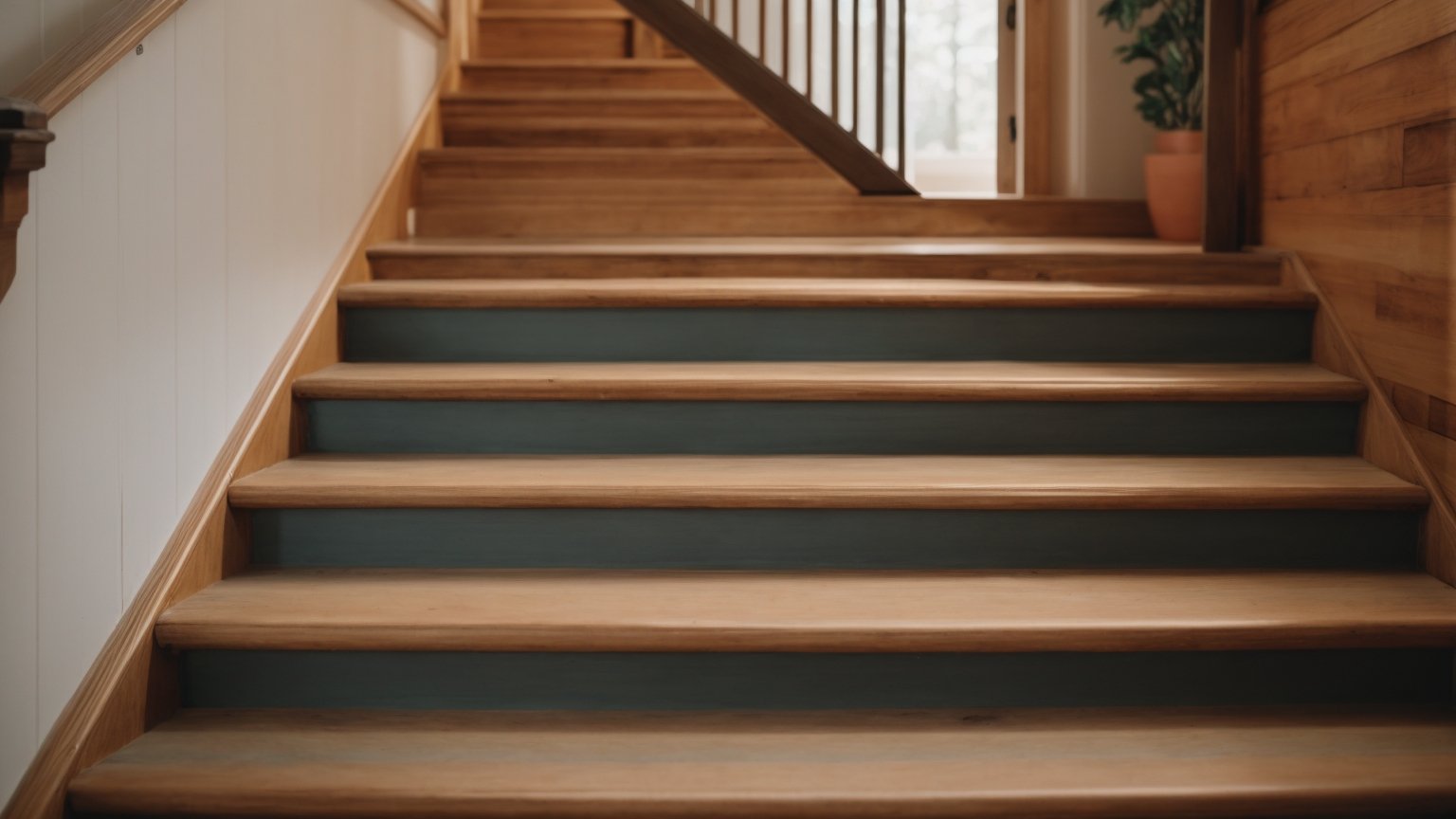If you’re looking to give your wooden stairs a fresh new look, painting them is a great option. Not only is it an affordable way to spruce up your home, but it’s also a relatively easy DIY project that can be completed in a weekend. Whether you’re looking to add a pop of color or simply refresh the existing finish, painting your stairs can make a big impact.
Before you get started, it’s important to properly prepare your stairs. This includes thoroughly cleaning and sanding the surface to ensure the paint adheres properly. You’ll also want to choose the right kind of paint for the job. Look for a high-quality floor paint that will withstand heavy foot traffic and provide a durable finish.
Once you’ve prepped your stairs and gathered your supplies, it’s time to start painting. Take your time and work in small sections, using a brush or roller to apply the paint evenly. Depending on the size of your staircase, you may need to apply multiple coats to achieve the desired finish. With a little patience and attention to detail, you can transform your wooden stairs into a beautiful focal point of your home.
Choosing the Right Materials

When it comes to painting wooden stairs, selecting the right materials is key to achieving a professional-looking finish that will last. In this section, we’ll cover the basics of choosing the right paint, brushes, and rollers for your project.
Selecting Paint
Choosing the right paint for your wooden stairs is crucial to ensure a durable and long-lasting finish. You’ll want to look for a paint that is specifically designed for use on floors and stairs, as these paints are formulated to withstand heavy foot traffic and wear and tear.
When selecting a paint, you’ll also want to consider the finish. High-gloss finishes are durable and easy to clean, but can be slippery underfoot. Satin or semi-gloss finishes offer a good balance of durability and slip resistance, while matte finishes are less durable but provide better traction.
Some recommended paints for wooden stairs include:
- Benjamin Moore Floor & Patio Paint
- PPG Floor & Porch Paint
- BEHR Premium Porch and Patio Floor Paint
Choosing Brushes and Rollers
Selecting the right brushes and rollers is just as important as choosing the right paint. For painting stairs, you’ll want to use a combination of brushes and rollers to ensure even coverage and a smooth finish.
For the flat surfaces of the stairs, use a high-quality roller with a short nap. This will help you apply the paint evenly and quickly. For the edges and corners of the stairs, use a small, angled brush to ensure precise application.
When selecting brushes and rollers, look for ones that are specifically designed for use with floor and stair paints. These brushes and rollers will have the right stiffness and thickness to apply the paint evenly and smoothly.
Some recommended brushes and rollers for painting wooden stairs include:
- Wooster Pro Doo-Z Roller
- Purdy XL Elite Glide Brush
- Wooster Shortcut Angle Sash Brush
By selecting the right paint, brushes, and rollers, you can ensure a professional-looking finish that will last for years to come.
Preparing the Wooden Stairs
Before you start painting your wooden stairs, it’s important to prepare the surface properly. This will ensure that the paint adheres well and that the finish is smooth and even.
Cleaning the Stairs
The first step in preparing your wooden stairs is to clean them thoroughly. This will remove any dirt, dust, or grime that may have accumulated on the surface. You can use a vacuum cleaner to remove loose dirt and debris, and then wipe down the stairs with a damp cloth and warm soapy water. Make sure to clean all the nooks and crannies, including the handrails and spindles. Once you have cleaned the stairs, allow them to dry completely before moving on to the next step.
Sanding the Surface
Once the stairs are clean and dry, it’s time to sand the surface. Sanding will help to smooth out any rough patches and create a surface that the paint will adhere to more easily. You can use a sanding block or an orbital sander to sand the stairs. Start with a coarse grit sandpaper and work your way up to a finer grit. Make sure to sand the entire surface of the stairs, including the edges and corners. Once you have finished sanding, wipe down the stairs with a clean, dry cloth to remove any dust or debris.
By properly cleaning and sanding your wooden stairs, you will create a smooth and even surface that is ready for painting. This will ensure that your paint job looks great and lasts for a long time.
Safety Measures
Painting your wooden stairs can be a fun and rewarding project, but it’s important to take safety measures to prevent accidents. Here are some things to keep in mind before you start:
1. Wear Protective Gear:
Before you start painting, make sure you have the right protective gear. Wear a dust mask to avoid inhaling dust particles, safety goggles to protect your eyes from paint splatters, and gloves to protect your hands from chemicals.
2. Prepare the Work Area:
Prepare the work area by removing any obstacles that could cause you to trip or fall. Cover the floor with a drop cloth to protect it from paint drips and spills. Make sure the area is well-ventilated by opening windows or using a fan.
3. Use the Right Tools:
Using the right tools is crucial to ensure your safety while painting stairs. Use a sturdy ladder that can support your weight and reach all areas of the stairs. Use a paintbrush with a comfortable grip to prevent hand fatigue.
4. Follow Proper Painting Techniques:
When painting stairs, it’s important to follow proper painting techniques to prevent accidents. Start at the top of the stairs and work your way down, painting one step at a time. Allow each step to dry completely before moving on to the next one.
5. Clean Up Properly:
After you finish painting, clean up properly to prevent accidents. Dispose of any paint cans, brushes, or rollers in a safe manner. Clean up any spills or drips immediately to prevent slipping.
By following these safety measures, you can ensure a safe and successful painting project.
Applying Primer
Before you start painting your wooden stairs, it’s important to apply a primer. A primer is essential because it helps the paint adhere better to the surface, and it also helps to seal the wood, preventing any stains or tannins from bleeding through the paint. Here’s how to apply primer to your wooden stairs:
Step 1: Clean the Stairs
Before you apply primer, make sure your stairs are clean and free of any dust, dirt, or debris. Use a vacuum cleaner or a soft-bristled brush to remove any loose dirt or debris. Then, wipe the stairs down with a damp cloth to remove any remaining dirt or dust.
Step 2: Sand the Stairs
Next, you’ll need to sand the stairs to create a smooth surface for the primer to adhere to. Use a fine-grit sandpaper (220-grit) and sanding sponge to sand the spindles, handrails, and any other wood surfaces to smooth them before painting. Vacuum up any sanding dust and wipe down your sanded surfaces with a damp cloth.
Step 3: Apply the Primer
Apply the primer using a medium-sized paintbrush or a roller. Make sure to apply the primer evenly and cover all areas of the stairs. If you’re using a sprayer, make sure to cover any nearby surfaces to prevent overspray. Let the primer dry completely before painting.
Step 4: Sand the Primer
Once the primer is dry, use a fine-grit sandpaper (220-grit) to lightly sand the surface. This will help to create a smooth surface for the paint to adhere to.
Step 5: Apply a Second Coat of Primer (Optional)
If necessary, apply a second coat of primer. This will help to ensure that the surface is fully covered and that the paint will adhere properly.
By following these steps, you’ll be able to apply primer to your wooden stairs and prepare them for painting.
Painting Techniques

When painting wooden stairs, it’s important to use the right techniques to ensure a smooth and long-lasting finish. Here are some tips to help you get the best results:
First Coat Application
Before applying the first coat of paint, make sure the stairs are clean and dry. Sand the surface lightly to remove any rough spots or imperfections. Then, apply a coat of primer to help the paint adhere better and provide a more even finish.
When applying the first coat of paint, use a brush or roller to apply the paint in long, even strokes. Start at the top of the stairs and work your way down, making sure to cover all areas evenly. Avoid applying too much paint at once, as this can cause drips and uneven coverage.
Adding Additional Coats
Once the first coat is dry, you can apply additional coats of paint as needed. Depending on the type of paint you’re using, you may need to apply two or more coats to achieve the desired finish.
Before applying each additional coat, lightly sand the surface to remove any bumps or imperfections. Then, apply the paint in the same manner as the first coat, using long, even strokes and avoiding applying too much paint at once.
If you notice any drips or uneven areas, use a brush or roller to smooth them out before the paint dries. Allow each coat to dry completely before applying the next coat.
By following these painting techniques, you can achieve a smooth and durable finish on your wooden stairs.
Drying and Curing
Once you have finished painting your wooden stairs, you will need to allow them to dry and cure properly. This process is essential to ensure that your stairs look their best and that the paint job lasts for a long time.
The drying time for your stairs will depend on a few factors, including the type of paint you used, the temperature and humidity in the room, and the airflow. In general, you should allow the stairs to dry for at least 24 hours before walking on them or putting any furniture back in place.
Curing, on the other hand, takes longer and involves the hardening and strengthening of the paint. This process can take up to a week or more, depending on the type of paint and the conditions in the room. During this time, it is important to avoid heavy traffic on the stairs, and to be careful when moving furniture or other objects.
To ensure that your stairs dry and cure properly, follow these tips:
- Keep the room well-ventilated by opening windows or using fans to circulate air.
- Avoid touching or bumping into the stairs during the drying and curing process.
- Wait at least 24 hours before walking on the stairs or putting any furniture back in place.
- Wait at least a week before cleaning the stairs or applying any additional coats of paint.
Properly drying and curing your painted wooden stairs is a crucial step in achieving a professional-looking finish that will last for years to come. So be patient, follow these tips, and enjoy your newly painted stairs!
Maintenance Tips
Once you’ve painted your wooden stairs, it’s important to maintain them properly to ensure they look great for years to come. Here are some maintenance tips to keep in mind:
- Regular Cleaning: Regularly clean your stairs with a soft-bristled brush or a vacuum cleaner to remove any dirt or debris. Avoid using abrasive cleaners or harsh chemicals that can damage the paint or wood.
- Touch-Ups: Over time, your stairs may develop scratches or chips. To keep them looking their best, touch up any damaged areas with a small brush and matching paint.
- Protective Coating: Consider applying a protective coating to your stairs to help prevent scratches, scuffs, and other damage. A clear polyurethane or varnish can help protect the paint and wood from wear and tear.
- Avoid Heavy Traffic: Try to avoid heavy traffic on your stairs, especially if you have pets or children who may scratch or damage the paint. Consider placing rugs or runners on your stairs to help protect them.
- Inspect Regularly: Regularly inspect your stairs for any signs of damage or wear and tear. Address any issues promptly to prevent them from getting worse.
By following these maintenance tips, you can keep your painted wooden stairs looking great for years to come.
